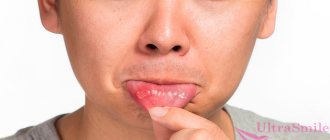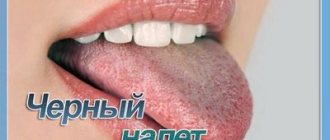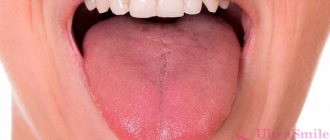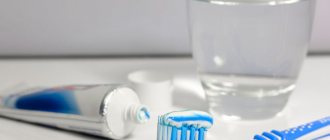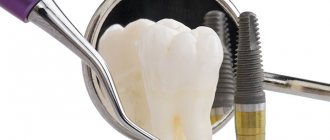Beautiful snow-white teeth are an important component of the image of a successful person. But for a number of reasons, the enamel becomes covered with an unaesthetic coating. This problem cannot be ignored, since soft plaque mineralizes and turns into tartar. It cannot be removed during normal oral hygiene. Deposits can only be removed by contacting the dentist.
If black plaque is not professionally removed , the patient will experience bad breath, darkening of the enamel, inflammation of the gums and the development of caries. As a result, he will have to treat the consequences that have arisen.
Why does plaque form on teeth?
Various factors can provoke the formation of plaque. It often consists of food debris, bacteria and is formed due to insufficient oral hygiene. But sometimes plaque appears even in those patients who regularly brush their teeth efficiently. Why? This is due to the darkening of the enamel under the influence of coloring pigments contained in coffee, strong black tea, and nicotine. In addition, a change in the aesthetic appearance of enamel is possible under the influence of certain medications, diseases of the liver, spleen, mouth rinses, as well as as a result of the activity of chromogenic bacteria (occurs in childhood).
Black plaque on teeth appears among workers in the metallurgical industry who daily inhale condensate containing microparticles of heavy metals. Units darken and collapse in people with drug addiction.
Reasons for the formation of black plaque
Before starting treatment, the doctor needs to determine why there is black plaque on the teeth, what initially caused its appearance and spread. There are several most common reasons:
- Poor oral hygiene. As practice shows, people often brush their teeth incorrectly, do not use mouthwash and dental floss, and do not clean hard-to-reach areas well enough. For many people, plaque begins to form on the far teeth - precisely in those places where the brush does not clean well. The deposits gradually begin to harden and darken.
- Diseases. These include diabetes mellitus, bacterial lesions, and gastrointestinal diseases. Also, a dense dark coating may indicate the appearance of disturbances in metabolic processes or hormonal imbalance.
- Taking certain groups of medications. A small list of potent drugs can cause darkening of teeth or the appearance of dense deposits on them.
Other reasons include using mouthwashes with a high percentage of phenol for hygiene and drinking coffee. Smokers also often experience plaque.
Particular attention should be paid to the problem if plaque appears in a child. Its presence may indicate that dangerous chromogenic bacteria have entered the body, there are concomitant diseases, and damage to the gastrointestinal tract.
In some cases, in children, the root of the problem lies in poor functioning of the salivary glands or the gradual development of caries, enamel hypoplasia, and calcium deficiency. You should definitely make an appointment for an unscheduled visit to the dentist to more accurately determine the cause of this problem.
What to do?
Many people want to clean their teeth from plaque at home. To do this, they use special bleaching pastes, soda, activated carbon, 3% hydrogen peroxide solution, and lemon juice. Sometimes, with slight darkening of the enamel, these methods give the desired effect.
But if you abuse such bleaching, as well as in case of increased sensitivity of the enamel, you can only harm yourself. Therefore, if you want to return your teeth to a snow-white shade, you need to start with a visit to a specialist. The dentist will assess the condition of the enamel, identify diseases of the oral cavity (if any) and recommend the best option for cleaning teeth from plaque.
In a clinical setting, there are several ways to get rid of deposits. Let's consider them in as much detail as possible. This will allow you to go for a consultation with a “theoretical savvy” specialist.
Localization options
Black plaque can be located on various parts of the tooth surface.
Depending on the location and anatomical and topographical areas of fixation, it can be:
- Supragingival. Located on the exposed surface of the tooth.
- Subgingival. It is formed in the area of the lower edge of the periodontium in the gingival groove or in the gingival pocket along the rim of the tooth.
- Dentogingival. Localized on smooth tooth surfaces.
- Proximal. Located on the contact areas of tooth enamel.
- Epithelially attached. Fixed to the periodontal epithelium.
- Subgingival-tooth-attached. Affects the entire surface of the dentition.
The main location of black plaque is the spaces between the teeth, their inner surface and the area near the gums.
Black plaque in a child
Black plaque in an adult
Professional Air Flow cleaning
This method is considered the most gentle on enamel and painless. The essence of the procedure is to influence deposits with a mixture of water, air and soda crystals, which is supplied under pressure. This way you can clean your teeth and the spaces between them.
The dentist recommends Air Flow cleaning to the patient in the following cases:
- the presence of plaque that turns into stone;
- discoloration of enamel caused by drinking strong tea, coffee, carbonated drinks, smoking;
- if it is necessary to install or remove crowns, braces, implants, high-quality cleaning of these systems;
- the presence of tightly spaced, twisted teeth in a row;
- the appearance of symptoms of periodontal disease.
Timely cleaning with such a device helps prevent the development of caries, gingivitis, periodontitis and periodontal disease. It allows you to effectively remove deposits on teeth, between units, even in the most inaccessible places, as well as on dental structures. At the same time, the enamel becomes lighter by 1-2 tones, pigment spots disappear. During polishing, the enamel is saturated with fluoride and strengthened.
Despite all the advantages of Air Flow, this procedure has a number of contraindications. In particular, it is not carried out when:
- severe pathologies of the respiratory system, including bronchial asthma;
- hepatitis;
- diabetes mellitus;
- tuberculosis;
- tendency to allergic reactions;
- HIV;
- infectious diseases;
- heart rhythm disturbances, presence of a pacemaker;
- increased sensitivity of enamel;
- the presence of areas of demineralization;
- installed titanium implants.
This method of professional cleaning is not recommended during pregnancy and lactation.
After the procedure, for 2-3 days the patient may complain of pain when eating cold and hot food. To reduce enamel sensitivity, you must use toothpaste labeled “Sensitive.” Be sure to buy a new brush with soft bristles.
During this period, it is better to exclude sour and sweet foods, cold and hot foods from the diet, refuse to drink carbonated drinks with dyes (including low-alcohol ones), coffee, strong black tea, and red wine. It is undesirable to eat red and orange fruits and vegetables.
Available means
There are always at least a few handy tools in the house to combat plaque.
Soda . The product is quite effective, but it must be used without fanaticism - no more than once a week. Otherwise, the enamel may be damaged.
Soda-salt solution . Dilute 1 tsp in 200 ml of water. soda and half a teaspoon of salt. Rinse your mouth with this solution for about 3 minutes before brushing your teeth.
Baking soda, lemon juice, or hydrogen peroxide can be used instead of regular toothpaste. But the procedure is traumatic, it is used only in extreme cases.
People often use hydrogen peroxide to whiten their teeth.
Activated carbon . Used as an abrasive instead of toothpaste. Capable of removing old plaque.
Whitening strips . Efficiency depends on their quality. Before use, you must carefully study the instructions.
Liquid rinses . They can only help in the early stages. You only need to buy it in pharmacies.
Ultrasonic cleaning with the “Vector” device
The German “Vector” system was created specifically to rid teeth of plaque. It effectively removes soft and hard mineralized deposits on the coronal part of units, as well as in periodontal pockets. The peculiarity of the procedure is the use of a special nozzle; ultrasound is applied strictly vertically (top to bottom and bottom to top). This allows you to remove deposits carefully, comfortably and painlessly. The entire process is controlled and predictable; during the procedure, the dentist adjusts the amplitude of the waves.
Thanks to the use of a special solution with hydroxyapatite granules, high-quality polishing of the surface of the crown and root occurs; after such cleaning, the appearance of new plaque occurs several times slower. In addition, the liquid promotes rapid regeneration of inflamed tissues, reduces sensitivity during the procedure and makes breathing fresh.
Plaque removal using the Vector device can be carried out when:
- gingivitis;
- periodontitis;
- identifying periodontal pockets 4-6 mm deep;
- increased sensitivity of teeth and gums;
- atrophic processes, exposure of the necks of units.
The procedure is contraindicated in childhood, during pregnancy and lactation, in the case of deep periodontal pockets filled with pus. Also, cleaning is not carried out if there is severe mobility of the units, the presence of malignant tumors in the body, severe heart disease, or if there is a pacemaker.
After the procedure, the doctor recommends using a new soft brush and toothpaste for sensitive teeth. In addition, you should give up coloring foods and drinks and smoking for 2-3 days.
Laser cleaning
This is an innovative, gentle and painless method of cleaning teeth from plaque of any color (black, yellow, etc.). During the procedure, the enamel is not damaged, and there is virtually no gum bleeding. Although this method of dealing with deposits is expensive, the investment is completely justified.
Benefits of laser teeth cleaning:
- removal of plaque and tartar, regardless of location;
- low level of pain, and therefore local anesthesia is not required;
- the ability to regulate the intensity of the impact;
- absence of noise and vibration, which is important for patients with dental phobia;
- non-contact - the device does not come into contact with tissues;
- safety of the procedure - the formation of enamel microcracks is excluded;
- no gum bleeding - even if tissue is damaged, the blood immediately coagulates under the influence of the laser;
- minimal risk of complications - the beam has a disinfecting effect, so during the procedure all pathogenic microorganisms are killed;
- rapid tissue restoration - due to stimulation of trophism and reparative processes;
- lightening the enamel by 1-3 tones;
- long-term effect - no plaque on the teeth for a year, provided proper care of the teeth and the oral cavity.
Laser deposit removal can only be performed by adults (over 18 years of age). It is not given to pregnant and lactating women if the patient has inflammation of the oral mucosa, severe heart pathologies or infectious diseases. Also contraindications are AIDS, HIV, bronchial asthma, chronic bronchitis.
Kinds
Let's look at the types of plaque on teeth:
| Classification | Description |
| Bacterial | Characterized by a soft, loose consistency. The presence of many specific bacteria is noted in the plaque. It can be easily removed from the tooth surface with a simple toothbrush. It is localized mainly in the cervical area of the tooth. Bacterial plaque may have a hard consistency. It is not removed by brushing your teeth. It is called bacterial stone. It is formed under the influence of calcium and phosphorus salts contained in saliva on soft microbial plaque. The cause of plaque is insufficient hygienic treatment of the oral cavity or its complete absence. If hygiene standards are violated, bacteria quickly grow and multiply, mainly immediately after eating. Their accumulation forms plaque near the necks and on the borders of the teeth. |
| Pigmentary | The reason for the appearance of this plaque in adults is the presence of polyphenolic compounds contained in tobacco, coffee beans, tea leaves and some foods. If hygiene habits are violated, pigmentation on the teeth, stones and bacterial plaque are immediately noticeable. Black pigmentation develops quickly in adults who do not brush their teeth. In this regard, pigment elements easily stick to the surface of the tooth on which there is bacterial plaque or stone. It is more difficult for pigments to stick to clean, smooth enamel. |
